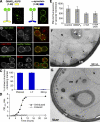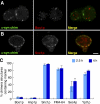α-Synuclein and ALPS motifs are membrane curvature sensors whose contrasting chemistry mediates selective vesicle binding
- PMID: 21746853
- PMCID: PMC3135411
- DOI: 10.1083/jcb.201011118
α-Synuclein and ALPS motifs are membrane curvature sensors whose contrasting chemistry mediates selective vesicle binding
Abstract
Membrane curvature sensors have diverse structures and chemistries, suggesting that they might have the intrinsic capacity to discriminate between different types of vesicles in cells. In this paper, we compare the in vitro and in vivo membrane-binding properties of two curvature sensors that form very different amphipathic helices: the amphipathic lipid-packing sensor (ALPS) motif of a Golgi vesicle tether and the synaptic vesicle protein α-synuclein, a causative agent of Parkinson's disease. We demonstrate the mechanism by which α-synuclein senses membrane curvature. Unlike ALPS motifs, α-synuclein has a poorly developed hydrophobic face, and this feature explains its dual sensitivity to negatively charged lipids and to membrane curvature. When expressed in yeast cells, these two curvature sensors were targeted to different classes of vesicles, those of the early secretory pathway for ALPS motifs and to negatively charged endocytic/post-Golgi vesicles in the case of α-synuclein. Through structures with complementary chemistries, α-synuclein and ALPS motifs target distinct vesicles in cells by direct interaction with different lipid environments.
Figures








Similar articles
-
Membrane trafficking: decoding vesicle identity with contrasting chemistries.Curr Biol. 2011 Oct 11;21(19):R811-3. doi: 10.1016/j.cub.2011.08.045. Curr Biol. 2011. PMID: 21996503
-
Membrane Curvature Sensing by Amphipathic Helices Is Modulated by the Surrounding Protein Backbone.PLoS One. 2015 Sep 14;10(9):e0137965. doi: 10.1371/journal.pone.0137965. eCollection 2015. PLoS One. 2015. PMID: 26366573 Free PMC article.
-
Alpha-synuclein-induced aggregation of cytoplasmic vesicles in Saccharomyces cerevisiae.Mol Biol Cell. 2008 Mar;19(3):1093-103. doi: 10.1091/mbc.e07-08-0827. Epub 2008 Jan 2. Mol Biol Cell. 2008. PMID: 18172022 Free PMC article.
-
Mechanisms of membrane curvature sensing.Annu Rev Biochem. 2011;80:101-23. doi: 10.1146/annurev-biochem-052809-155121. Annu Rev Biochem. 2011. PMID: 21438688 Review.
-
The Role of Lipids Interacting with α-Synuclein in the Pathogenesis of Parkinson's Disease.J Parkinsons Dis. 2017;7(3):433-450. doi: 10.3233/JPD-171103. J Parkinsons Dis. 2017. PMID: 28671142 Review.
Cited by
-
Cooperativity of α-Synuclein Binding to Lipid Membranes.ACS Chem Neurosci. 2021 Jun 16;12(12):2099-2109. doi: 10.1021/acschemneuro.1c00006. Epub 2021 Jun 2. ACS Chem Neurosci. 2021. PMID: 34076426 Free PMC article.
-
Neutral lipids regulate amphipathic helix affinity for model lipid droplets.J Cell Biol. 2020 Apr 6;219(4):e201907099. doi: 10.1083/jcb.201907099. J Cell Biol. 2020. PMID: 32328636 Free PMC article.
-
Mitochondrial bioenergetics decay in aging: beneficial effect of melatonin.Cell Mol Life Sci. 2017 Nov;74(21):3897-3911. doi: 10.1007/s00018-017-2619-5. Epub 2017 Aug 7. Cell Mol Life Sci. 2017. PMID: 28785806 Free PMC article. Review.
-
Alpha-synuclein structure, functions, and interactions.J Res Med Sci. 2016 May 9;21:29. doi: 10.4103/1735-1995.181989. eCollection 2016. J Res Med Sci. 2016. PMID: 27904575 Free PMC article. Review.
-
An inducible amphipathic α-helix mediates subcellular targeting and membrane binding of RPE65.Life Sci Alliance. 2022 Oct 20;6(1):e202201546. doi: 10.26508/lsa.202201546. Print 2023 Jan. Life Sci Alliance. 2022. PMID: 36265895 Free PMC article.
References
Publication types
MeSH terms
Substances
LinkOut - more resources
Full Text Sources
Other Literature Sources

